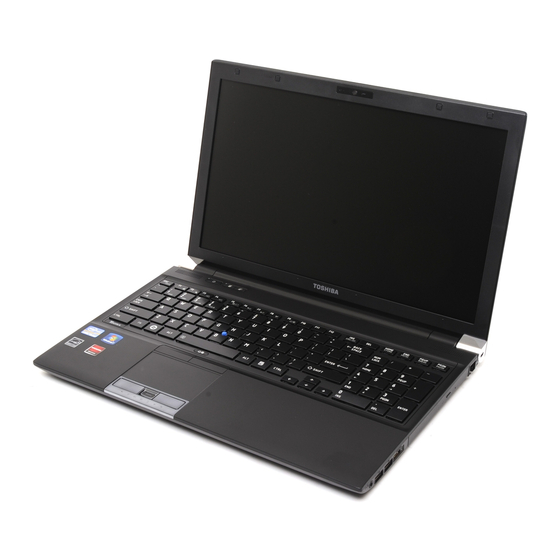Summarization of Contents
Chapter 1 Getting Started
Equipment checklist
List of hardware and documentation items included with the computer.
Getting Started
Basic information and steps to begin using the computer.
Chapter 2 The Grand Tour
The Grand Tour for R850
Identifies front view components of the R850 model with the display closed.
Left side (R850)
Identifies ports and features on the left side of the R850 model.
The Grand Tour for R840
Identifies front view components of the R840 model with the display closed.
Left side (R840)
Identifies ports and features on the left side of the R840 model.
The Grand Tour for R830
Identifies front view components of the R830 model with the display closed.
Left side (R830)
Identifies ports and features on the left side of the R830 model.
Chapter 3 Operating Basics
Using the Touch Pad
Instructions on how to use the Touch Pad for cursor control.
The Keyboard
Describes the computer's keyboard layout and key types.
Hot key functions
Details how hot key functions enable or disable computer features.
Optical disc drives
Describes the computer's optical disc drive capabilities and supported formats.
Memory media slot
Describes the memory media slot and its compatibility with various memory cards.
Additional memory module
Explains how to install and remove optional memory modules to increase system memory.
External monitor
Explains how to connect an external analog monitor to the computer.
HDMI
Explains how to connect an HDMI monitor to the computer's HDMI out port.
DisplayPort
Explains how to connect an external monitor using the DisplayPort.
eSATA (External Serial ATA) devices
Explains how to connect eSATA devices to the computer.
Chapter 4 Utilities & Advanced Usage
Utilities and Applications
Describes pre-installed software utilities and how to start them.
TOSHIBA Face Recognition
Explains how Face Recognition verifies user identity for automatic Windows login.
HW Setup
Explains how to use the HW Setup program to configure computer hardware settings.
Using the Hard Disk Drive (HDD) Protection
Explains the function for reducing hard disk drive damage risk using an acceleration sensor.
System Recovery
Explains the process of system recovery using a hidden partition or recovery media.
Chapter 5 Power and Power-Up Modes
Power conditions
Explains how operating capability and battery status are affected by power conditions.
Monitoring of power condition
Describes how to check the computer's operating capability and battery status via indicators.
Battery
Explains battery types, use, recharging methods, and handling.
Charging the batteries
Explains how to charge the battery pack and the procedures involved.
Extending battery life
Offers tips on how to prolong the usable life of battery packs.
Replacing the battery pack
Explains how to remove and install the battery pack.
Power-up modes
Describes the three power-up modes: Shut Down, Hibernation, and Sleep.
Chapter 6 Troubleshooting
Problem solving process
Guidelines for efficiently resolving computer issues by observation and documentation.
Hardware and system checklist
Lists common problem areas in hardware and system components for basic troubleshooting.
AC power
Troubleshooting tips for issues related to the AC adapter and power supply.
Battery
Troubleshooting steps for suspected battery problems.
Keyboard
Troubleshooting common keyboard issues, like keys producing numbers or garbled output.
Hard disk drive
Troubleshooting steps for issues related to booting from the hard disk drive or slow performance.
Dual Pointing device
Addresses troubleshooting for the Touch Pad and AccuPoint pointing devices.
TOSHIBA support
Information on how to contact TOSHIBA for technical assistance and where to find further help.
Appendix A Specifications
Physical Dimensions
Lists the physical dimensions of the R850, R840, and R830 models.
Environmental Requirements
Details the ambient temperature, relative humidity, and altitude requirements for operation and non-operation.
Appendix B AC Power Cord and Connectors
Certification agencies
Lists various certification agencies for power cords in different regions.
Appendix C Legal Footnotes
CPU
Discusses CPU performance variations and potential automatic shutdown conditions.
Memory (Main System)
Explains how main system memory is used by the graphics system and limitations in 32-bit OS.
Battery Life
Discusses factors affecting battery life, recharge time, and battery replacement.
Appendix D Information for Wireless Devices
Wireless LAN Interoperability
Details Wireless LAN compatibility with other LAN systems and standards.
Bluetooth wireless technology Interoperability
Explains Bluetooth interoperability with products using specific Bluetooth specifications.
Wireless Devices and your health
Discusses electromagnetic energy emitted by wireless products and safety recommendations.










Need help?
Do you have a question about the Satellite R830 Series and is the answer not in the manual?
Questions and answers